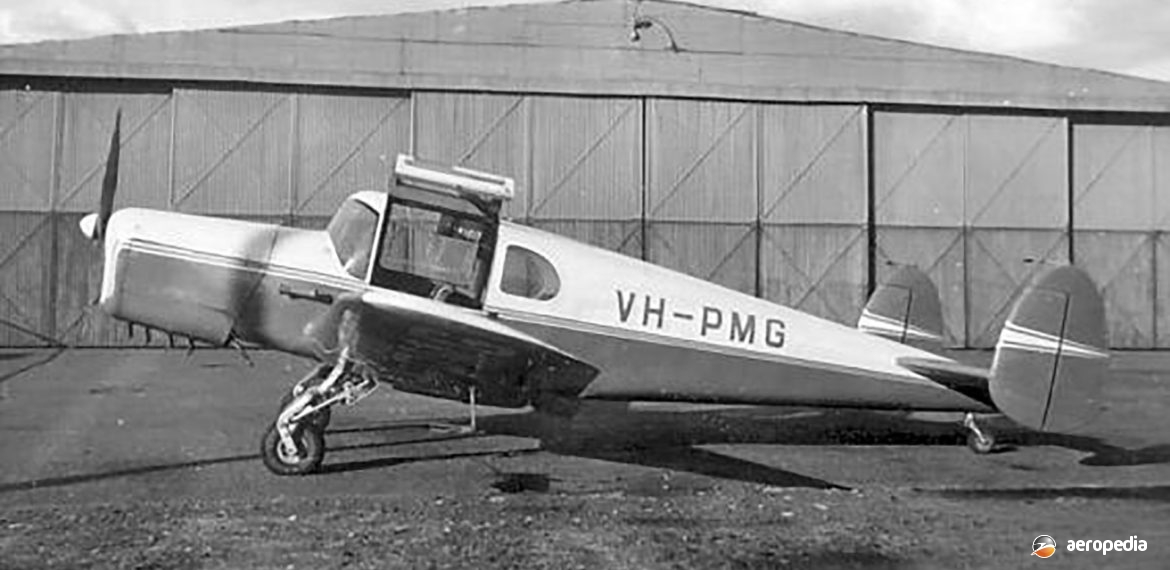Photograph:
Miles M.28 Mercury VH-PMG (c/n not known) at Moorabbin, VIC in 1956 (Eddie Coates Collection)
Country of origin:
United Kingdom
Description:
Light touring monoplane
Power Plant:
One 108 kw (145 hp) de Havilland Gipsy Major III four-cylinder in-line air-cooled engine
Specifications:
- Wingspan: 9.38 m (30 ft 8 in)
- Length: 7.32 m (24 ft)
- Height: 2.54 m (8 ft 4 in)
- Max speed at sea level: 256 km/h (160 mph)
- Max cruising speed at 1,100 m (3,600 ft): 240 km/ h (155 mph)
- Stalling speed: 76 km/h (46 mph)
- Initial rate of climb: 305 m/min (1,000 ft/min)
- Range: 770 km (480 miles)
- Fuel capacity: 109 litres (24 Imp gals)
- Empty weight: 663 kg (1,460 lb)
- Loaded in trainer/aerobatic category: 938 kg (2,067 lb)
- Loaded weight as four seater: 1,102 kg (2,427 lb)
History:
The Miles M.28 Mercury was a three/four-seat light touring monoplane of similar configuration to the later M.38 Messenger and, although only a small number were built, no two aircraft were the same and all had different designations. Designed by G H Miles, and built at the Miles facility at Woodley, UK in 1942, the first aircraft in the series, the M.28 Mercury 2 (U-0237, later HM583) was first flown with a 108 kw (145 hp) de Havilland Gipsy Major IIA engine, but this was replaced later by a 104 kw (140 hp) Blackburn Cirrus Major II engine. After seeing some military service with the RAF during World War II it was placed on the British civil register in 1947 as G-AJVX, fitted with a 112 kw (150 hp) Blackburn Cirrus Major III engine, and operated by Hulland Gravel Co of Burbaston, UK.
It was later sold to Mr J E Nicholson and registered in Australia in June 1950 as VH-BBK (c/n unknown). It was flown to Australia by Mr F Burt in 64 days, arriving in Perth, WA on 17 January 1951. It was re-registered VH-PMG on 10 June 1956 to Mr G Greig of Newcastle, NSW; and later again became VH-KCH. However, like a number of aircraft of the period, due to the type of glue used in its wooden construction, it was grounded by DCA policy in 1963 and its ultimate fate is not known.
Construction of the fuselage was all wood with plywood covering. The wings were low-cantilever monoplane units tapering slightly and of all-wood construction fitted with Miles low-drag auxiliary aerofoil flaps between ailerons and fuselage and hinged air-brakes under the fuselage, the ailerons drooping when the flaps were extended. The tail unit was of the cantilever monoplane type with twin fins and rudders.
Because of wartime commitments, only six examples of the series were built. Other variants of the design included the Mercury 3 (U-0242, PW937, G-AISH – c/ n 4684) built in 1943; the Mercury 5 (G-AJFE – later HB-EEF – c/ n 6617); and the Mercury 6 (G-AHAA, later D-EHAB, c/ n 6268). At least one Mercury survives, this being a Mk 6 (OY-ALW) in Denmark.
The Mercury 4 had a 108 kw (145 hp) de Havilland Gipsy Major IIA engine with a constant speed propeller. A four seater, only one example was built (U-0243, G-AGVX, HB-EED, VH-AKH, VH-AKC – c/n 4685). First registered to Miles Aircraft, it flew with a test registration and then was registered in Britain before going to Aerotaxi AG in Switzerland in April 1947. It returned to the United Kingdom for a period and had a series of owners before being brought to Australia in May 1953, where it operated for a period in Charleville, QLD as VH-AKH². On 27 December 1955 the registration was changed to VH-AKC but on 31 December 1963 it was grounded due to DCA policy and its fate is not known.

